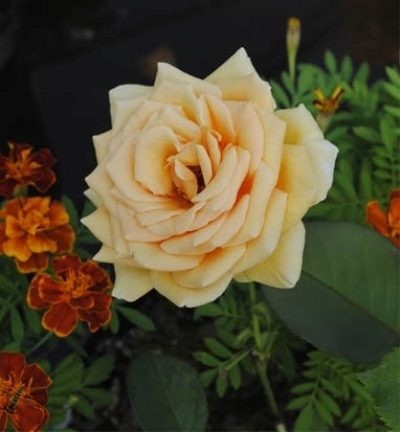
- Authors: Kordes
- Name synonyms: Valencia
- Breeding year: 1987
- Group: tea-hybrid
- The main color of the flower: orange
- Flower shape: cupped
- Flower size: large
- Diameter, cm: 12-13
- Flower type by number of petals: thick double
- Scent: sweet
Rose Valencia (Valencia) has been around for many years. Over the years, she managed to win the love and respect of flower growers. It is chosen for its beautiful appearance and attractive aroma.
Breeding history of the variety
The variety originated in 1987 in Germany thanks to the breeders of the Kordes company (W. Kordes Sohne).
Description of the variety
The culture is classified as tea hybrids. It is a vigorous, somewhat sloppy bush, towering 60-70 centimeters above the ground. The bush is up to 40 centimeters wide. Has a dense foliage with leaves of a rich green color. On strong stems, one large cup-shaped flower with a diameter of 12-13 centimeters is formed.
Roses are densely double, they have 35-50 petals. The buds are pointed, oblong, oval in shape. The flower's color is bright, but not motley. When the rose is just starting to bloom, the bud is painted in a bronze tone. As it ripens, the color turns into apricot orange with a bronze tint. Valencia exudes a strong sweet scent, which is recognizable with fruity notes.
Advantages and disadvantages
Noting the advantages of the hybrid in question, they focus on the beauty of the plant: its bright, impressive flowers can transform even the most modest suburban area. You can admire them and inhale their wonderful aroma all summer long. In addition, Valencia does not die in winter and actively resists a number of fungal diseases, is adapted to the heat.
Among the shortcomings of this beauty, one can note the need for systematic feeding and some whims: with inaccurate pruning, the flower will refuse to form buds. It also does not resist rainfall very well.
Flowering features
The bush is characterized by a long flowering period that starts in June and ends only in September. The flowering intensity can range from moderate to profuse. During the season, the process can be repeated two times.
Use in landscape design
This tea hybrid will make a picturesque duet with evergreen shrubs in a hedge, will harmoniously fit into the composition of a lawn, flower beds, decorate an alley, terrace, curb, slope, mixborder.
Growing regions
The described variety is recommended for cultivation in Siberia, North-West, Central and other regions of Russia.
Landing
It is permissible to plant a hybrid twice: in springtime (April, May) and in early autumn. On the eve of planting, a pit is prepared, the depth of which should be about 60 centimeters. The bottom is covered by 10 centimeters with drainage materials (crushed stone, stones, gravel). Then a 10-centimeter layer of earth from the garden is laid out in a domed manner.
A young plant is placed in a planting hole so that the root collar is three centimeters submerged in the soil. At the end of the process, the shrub is moistened, water is poured under the root. The soil around the flower is mulched; peat can be used for this.
Growing and caring
For the cultivation of Valencia, experts advise choosing a well-lit and ventilated part of the garden. The rosette feels comfortable in light, drained, loose, fertile, oxygenated and organic soil. Taking care of the culture, you need to irrigate it in a timely manner, cut it off, weed it from weeds, loosen it, and heal it.
Watering the shrub is carried out a couple of times a week, each flower takes about 20 liters of heated water.At the end of the season, the frequency of watering is reduced, and in September there is no need to moisten it at all. Top dressing is introduced in the spring (nitrogenous compounds) and in the fall (phosphorus-potassium complexes).
It is advisable to carry out the pruning procedure in Valencia in spring, summer and autumn. In the spring, rejuvenating pruning is performed, keeping only 2-4 buds on the shoots. Summer is a time of weak pruning, when faded inflorescences are removed. In the fall, you need to do sanitary pruning - to cut off unhealthy shoots.
The hybrid is characterized by high winter hardiness, is able to withstand at temperatures of -29 degrees. In order to help the plant survive the frosts, a caring owner prepares a frame structure, wraps the flowers with non-woven material.
Diseases and pests
The culture shows an average degree of resistance to black spot. It is ill infrequently, mainly due to mistakes in care.
Reproduction
For propagation of the described variety of roses, the method of grafting is used. Cuttings of healthy plants of the first flowering wave are successfully rooted.
Review overview
Most of the growers leave rave reviews about the above-described variety. Summer residents praise Valencia for its beauty, delicious aroma, long flowering. The only complaint is the average resistance to rain and the possibility of disease.































































